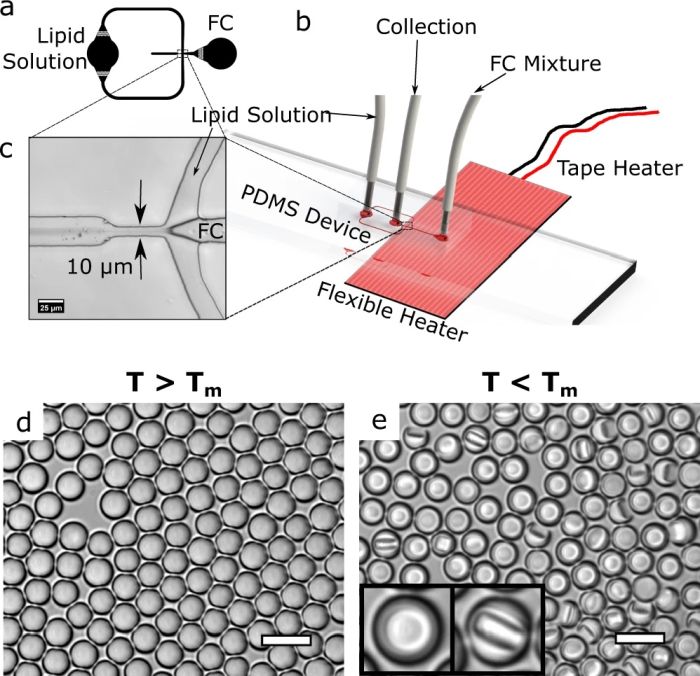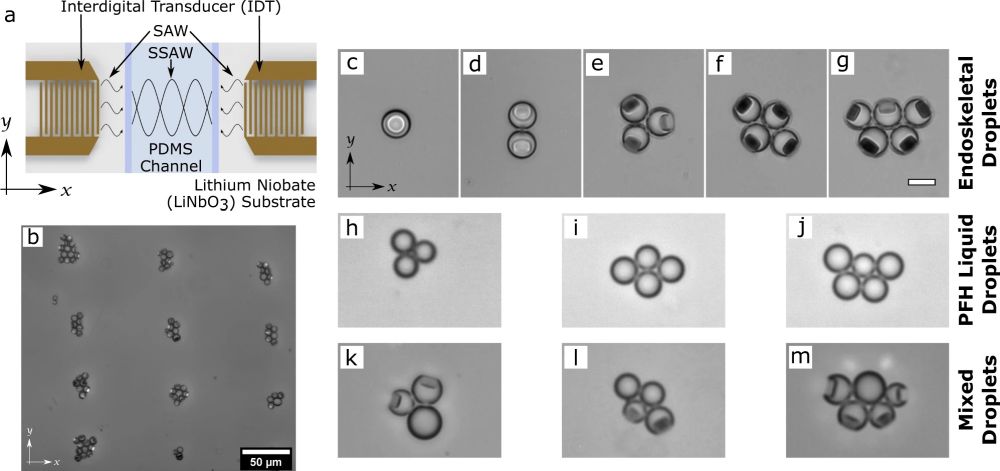
28 Feb Acoustic manipulation of endoskeletal droplets on a microfluidic platform
As droplet microfluidics progresses, more sophisticated applications get developed by researchers which in turn require more complex techniques for manipulation. One class of such droplets is endoskeletal droplets. Endoskeletal droplets are complex colloids in which a solid phase is cast within a liquid emulsion. This solid phase facilitates more controllability over the shape and the orientation of the droplets in response to external stimuli. In this week’s research highlight, we will introduce a microfluidic chip that enables researchers to manipulate disk-in-sphere endoskeletal droplets using acoustic waves to form clusters.
“Manipulation of internal structure of droplet/particle is rarely explored and remains challenging due to its complicated nature. Here we demonstrated the manipulation of internal structure of disk-in-sphere endoskeletal droplets using acoustic wave. We developed a model to investigate the physical mechanisms behind this interesting phenomenon. Theoretical analysis of the acoustic interactions indicated that these assembly dynamics arise from a balance of the primary and secondary radiation forces.”, the authors explained.

“a Design of the Microfluidic Channel used to generate droplets. b Droplet generation schematic showing the PDMS device and different inlets and outlets. Zoomed in image of the flow-focusing junction is shown in c Scale bar, 25 μm. d Endoskeletal droplets generated using this technique at a higher temperature (T > Tm) are single-phase liquid droplets where the solid disks are all melted. When the droplets are cooled to a lower temperature (T < Tm), the solid phase separates and forms the endoskeleton confined by the droplet boundaries (shown in e). The disks are randomly oriented with different orientations. Parallel orientation and perpendicular orientation of the disk are shown in the image inserts where the disks are seen as circle and rectangle respectively. Scale bar, 20 μm.” Reproduced under Creative Commons Attribution 4.0 International License from Shakya, G., Yang, T., Gao, Y. et al. Acoustically manipulating internal structure of disk-in-sphere endoskeletal droplets. Nat Commun 13, 987 (2022).
The working mechanism of the microfluidic device
The proposed microfluidic device consisted of two separate microfluidic chips both microfabricated with PDMS using standard photo/soft lithography techniques. The first microfluidic chip was a flow-focusing microfluidic droplet generator that was pre-coated to make the surface more hydrophilic. The other microfluidic chip was microfabricated for SAW experiments. The solutions were pre-warmed before running them through the microfluidic chip to melt the reagents. The syringes were covered with a syringe heater to keep the reagents warm. Therefore, the microfluidic flow-focusing chip made ~5 µm isotropic droplets. The droplets were then cooled down so the PFDD could solidify and create the disk shape structure within the droplets. Microscope images of the droplets confirmed that the solid disk shape structures were formed successfully and could move inside the droplets with no hassle. Next, the droplets were diluted 10x and a 10 µL fraction was pipetted at the edge of the PDMS microfluidic channel which then flowed through the device through the microfluidic device via capillary force where they were exposed to the SAW electrodes.

“a Schematic of the SAW IDT devices used for patterning experiments. b Clustering behavior of endoskeletal droplets under 1D standing SAW. Scale bar, 50 μm. Zoomed in images of the droplet clusters under 1D standing SAW with 1 droplet (c), 2 droplets (d), 3 droplets (e), 4 droplets (f), 5 droplets (g). Note that the disk orientations are different for smaller clusters (c and d) compared to larger clusters (e–g). h, i, j Liquid PFH droplet show similar clustering behavior as endoskeletal droplets. k, l, m Clusters containing mixture of liquid only PFH droplets and endoskeletal droplets. Note that the clustering phenomenon is the same for all three types of droplets clusters and the disk orientations are not affected by the absence of other disks as well. Scale bar for all individual cluster images, 10 μm.” Reproduced under Creative Commons Attribution 4.0 International License from Shakya, G., Yang, T., Gao, Y. et al. Acoustically manipulating internal structure of disk-in-sphere endoskeletal droplets. Nat Commun 13, 987 (2022).
Having transferred the endoskeletal droplets to the microfluidic chamber, the team then exposed them to acoustic waves. The surface acoustic waves (SAW) with a center frequency of 20 MHz were generated to examine the effect on the collective behaviour of the droplets. It was shown that the droplets formed clusters as soon as the SAW was turned on. Depending on the number of droplets in the cluster, the orientation of the droplets changes with respect to the substrate.
“This reversible on-demand manipulation of the disk orientation can potentially be utilized in various filtering as well as imaging applications. This distinctive dynamic manipulation could potentially provide further opportunities for directed colloidal assembly with dynamic and acoustically tunable internal structures and pave the way towards manipulation of the internal structures of organoids and cells.”, the authors concluded.
Figures and the abstract are reproduced from Shakya, G., Yang, T., Gao, Y. et al. Acoustically manipulating internal structure of disk-in-sphere endoskeletal droplets. Nat Commun 13, 987 (2022). https://doi.org/10.1038/s41467-022-28574-4 under Creative Commons Attribution 4.0 International License
Read the original article: Acoustically manipulating internal structure of disk-in-sphere endoskeletal droplets


